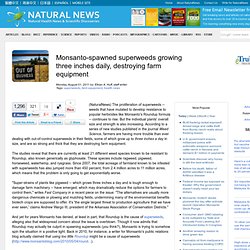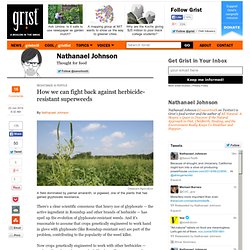

Des plantes adventices ou mauvaises herbes devenues résistantes au glyphosate. ISIS Report 03/03/10 Les mauvaises herbes résistantes au glyphosate peuvent annoncer la fin des cultures des plantes brevetées tolérantes aux herbicides, mais les agriculteurs peuvent-ils quitter le tapis roulant ‘transgénique' qui est très profitable pour Monsanto?

Prof. Joe Cummins Un problème d'évolution L'herbicide glyphosate a été breveté et vendu par la société Monsanto depuis 1974 sous le nom commercial et comme spécialité exclusive de ‘Roundup'. Le glyphosate est un herbicide à large spectre qui empoisonne de nombreuses espèces végétales,de sorte qu'il est souvent utilisé pour «brûler» les mauvaises herbes sur un terrain avant le semis ou l'émergence de cultures.
De même dans les zones de cultures transgéniques résistantes au glyphosate en Argentine et au Brésil, il y a maintenant des populations qui ont évolué et qui sont devenues résistantes au glyphosate, comme le sorgho d'Alep (Sorghum halepense) et une euphorbe mexicaine (Euphorbia heterophylla) [2]. Conclusion 1. 2. 3. Ogm.2_vf.pdf (Objet application/pdf) L’amarante plus forte que Monsanto ? « 1+1=salade ? Amaranthus retroflexus Je n’aurai de cesse de faire l’éloge de la mauvaise herbe.

Aujourd’hui, David-l’amarante, Amaranthus retroflexus L. de son petit nom, 12 000 graines par an en moyenne avec une durée germinative de 20 à 30 ans; contre Goliath-Monsanto, 8 563 milliards de $ de chiffre d’affaires. Je ne résiste pas à vous citer un extrait de l’article intitulé «OGM: la menace des super mauvaises herbes s’amplifie» : L'amarante Pourrie la Vie des OGM de Monsanto - lespacearcenciel sur LePost.fr (13:35) Elle est marrante l'Amarante : elle désespère Monsanto ! Monsanto-spawned superweeds growing three inches daily, destroying farm equipment. (NaturalNews) The proliferation of superweeds -- weeds that have mutated to develop resistance to popular herbicides like Monsanto's Roundup formula -- continues to rise.

But the individual plants' overall size and strength is also increasing. According to a series of new studies published in the journal Weed Science, farmers are having more trouble than ever dealing with out-of-control superweeds in their fields, some of which grow up to three inches a day in size, and are so strong and thick that they are destroying farm equipment. The studies reveal that there are currently at least 21 different weed species known to be resistant to Roundup, also known generically as glyphosate. These species include ragweed, pigweed, horseweed, waterhemp, and ryegrass. Since 2007, the total acreage of farmland known to be infested with superweeds has also jumped more than 450 percent, from 2.4 million acres to 11 million acres, which means that the problem is only going to get exponentially worse.
OGM: les super mauvaises herbes contre-attaquent - Page 2. GMO crop gone wild. Turf war: In the battle for our crops, superweeds are winning. Biotech crops, which represent almost all the corn, soy, and cotton grown in the U.S., have finally met their match.

And it’s not (only) the millions of consumers demanding labels on food that contains genetically modified crops, or GMOs. As NPR reports, biotech’s super-nemesis is legions of weeds and bugs that have grown immune to the herbicides and pesticides that many of these crops require. Generally speaking, GMO crops fall into two categories: Some are designed to be resistant to pesticides like Roundup, Monsanto’s all-purpose weed killer. This allows farmers to douse fields with Roundup, killing everything but the corn, soy, or cotton (most commonly) that they’re trying to grow.
Other GMO crops actually exude chemicals such as Bt, a “natural” pesticide that kills many of the most damaging bugs. The technology may or may not be deserving of the World Food Prize but it’s certainly been a huge business success. Rotations are, however, more complicated. What are Superweeds? How we can fight back against herbicide-resistant superweeds. There’s a clear scientific consensus that heavy use of glyphosate — the active ingredient in Roundup and other brands of herbicide — has sped up the evolution of glyphosate-resistant weeds.

And it’s reasonable to assume that crops genetically engineered to work hand in glove with glyphosate (like Roundup-resistant soy) are part of the problem, contributing to the popularity of the weed killer. Now crops genetically engineered to work with other herbicides — such as dicamba and 2,4-D — look like they will soon come on line. The seed companies’ answer to the Roundup-resistance problem is: Let’s just fall back on older herbicides. An editorial published by the journal Nature recently criticized this plan.
If we do the same thing with dicamba and 2,4-D that we did with glyphosate, the editorial argued, history is likely to repeat itself. This got me wondering what we should do, then, so I started calling weed scientists. What’s the best way through this tough spot?